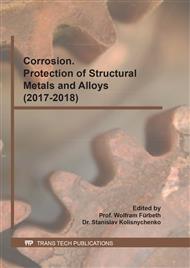[1]
A. H. Lu, E. e. L. Salabas, and F. Schüth, Ang Chem Interl Edi. Vol. 46(8) (2007), pp.1222-1244.
Google Scholar
[2]
P. C. Okafor and Y. Zheng, Corros. Sci. Vol. 51 (2009), p.850.
Google Scholar
[3]
B. Qian, B. Hou, and M. Zheng, Corros. Sci. Vol. 72 (2013), pp.1-9.
Google Scholar
[4]
A. Raman, B. Kuban, and A. Razvan, Corros. Sci. Vol. 32 (1991), p.1295.
Google Scholar
[5]
A. Collazo, X. Novoa, C. Pérez, and B. Puga, Electrochim Acta. Vol. 55 (2010), p.6156.
Google Scholar
[6]
A. Rahim, M. Kassim, E. Rocca, and J. Steinmetz, Corros Eng, Sci Technol. Vol. 46 (2011), pp.425-431.
Google Scholar
[7]
H. Ashassi-Sorkhabi, D. Seifzadeh, and M. Hosseini, Corros. Sci. Vol. 50(2008), p.3363.
Google Scholar
[8]
M. Morad and A. K. El-Dean, Corros. Sci. Vol. 48 (2006), p.3398.
Google Scholar
[9]
S. Shibli and V. Saji, Corros. Sci. Vol. 47 (2005), p.2213.
Google Scholar
[10]
H. C. Cui, D. C. Li, and J. L. Li: Adv Mater Res. Vol. Trans Tech Publ (2011). pp.82-86.
Google Scholar
[11]
C. -c. Li, X. -y. Guo, S. Shen, P. Song, T. Xu, Y. Wen, and H. -F. Yang, Corros. Sci. Vol. 832014, p.147.
Google Scholar
[12]
S. Shen, J. Du, X. -y. Guo, Y. Wen, and H. -F. Yang, Appl Surf Sci, Vol. 327(2015), pp.116-121.
Google Scholar
[13]
M. A. Chidiebere, E. E. Oguzie, L. Liu, Y. Li, and F. Wang, Ind. Eng. Chem. Res. Vol. 53 (2014), pp.7670-7679.
Google Scholar
[14]
P. Zareitalabad, J. Siemens, M. Hamer, and W. Amelung, Chemosphere. Vol. 91(2013). pp.725-732.
Google Scholar
[15]
K. E. Holmström, U. Järnberg, and A. Bignert, Envir sci technol, Vol. 39(2005), p.80.
Google Scholar
[16]
E. Oguzie, C. Enenebeaku, C. Akalezi, S. Okoro, A. Ayuk, and E. Ejike, J. Am. Chem. Soc. Vol. 349 (2010), p.283.
DOI: 10.1016/j.jcis.2010.05.027
Google Scholar
[17]
J. Hu, S. Cao, L. Yin, Q. Liang, and J. Xie, Anti-Corros. Methods Mater, Vol. 59(2012), p.305.
Google Scholar
[18]
J. -Y. HU, S. -A. CAO, and J. -L. XIE, Acta Phy-Chim Sin. Vol. 28(2012), p.1153.
Google Scholar
[19]
M. A. Chidiebere, C. E. Ogukwe, K. L. Oguzie, C. N. Eneh, and E. E. Oguzie, Ind. Eng. Chem. Res. Vol. 51 (2012), p.668.
DOI: 10.1021/ie201941f
Google Scholar
[20]
H. Sun, P. Ren, and J. Fried, Acta Phys. Chim. Sin, Vol. 8(1998), pp.229-246.
Google Scholar



